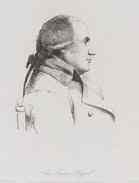The directory «Artists»
Rigaud John Francis
(1742—1810)

Painter of portraits, history and decorative pieces. Born in Italy of French descent, he was mainly active in England. He trained in his native Turin as well as Florence and Bologna. After a two-year stay in Rome (1768–70) he moved to London in 1771. He was confident with both small and large scales as well as popular and unconventional subjects. In ‘The Entry of the Black Prince into London with his Royal Prisoner’, 1774, (location unknown) he explored the chivalric legend of Edward, Prince of Wales. His major patron was Heneage Finch, Fourth Earl of Aylesford, for whom he decorated the Pompeian Gallery at Packington Hall, Warwickshire, in 1787. Many of Rigaud’s important works have been lost but are known from surviving drawings and prints. His decorations of the Common Council Chamber in the Guildhall, London, depicting personifications of ‘Providence, Innocence, Wisdom and Happiness’ (1794), are known from a preparatory sketch and the small, sentimental ‘Scene from Romeo and Juliet’ (1796) from an engraving. He was a member of the art academies in Bologna and London. His portrayal of fellow academicians ‘Sir William Chambers; Joseph Wilton; Sir Joshua Reynolds’ (1782, National Portrait Gallery, London) is a good example of his elegant style.
Antigua, 1970, Admiral Lord Nelson
Ascension Island, 2005, British carronade
Ascension Island, 2005, Admiral Lord Nelson
Ascension Island, 2005, HMS «Neptune» and «Santissima Trinidad»
Ascension Island, 2005, HMS «Victory»
Gambia, 2005, Admiral Lord Nelson
Gibraltar, 1980, Horatio Nelson
Liberia, 2005, Fall of Nelson
Nevis, 1983, Nelson, HMS «Boreas»
Nevis, 1987, Captain Nelson
Nevis, 2005, Lord Howe on the Deck of the «Queen Charlotte»
Sierra Leone, 2005, Battle of Trafalgar
Solomon Islands, 2005, Admiral Lord Nelson